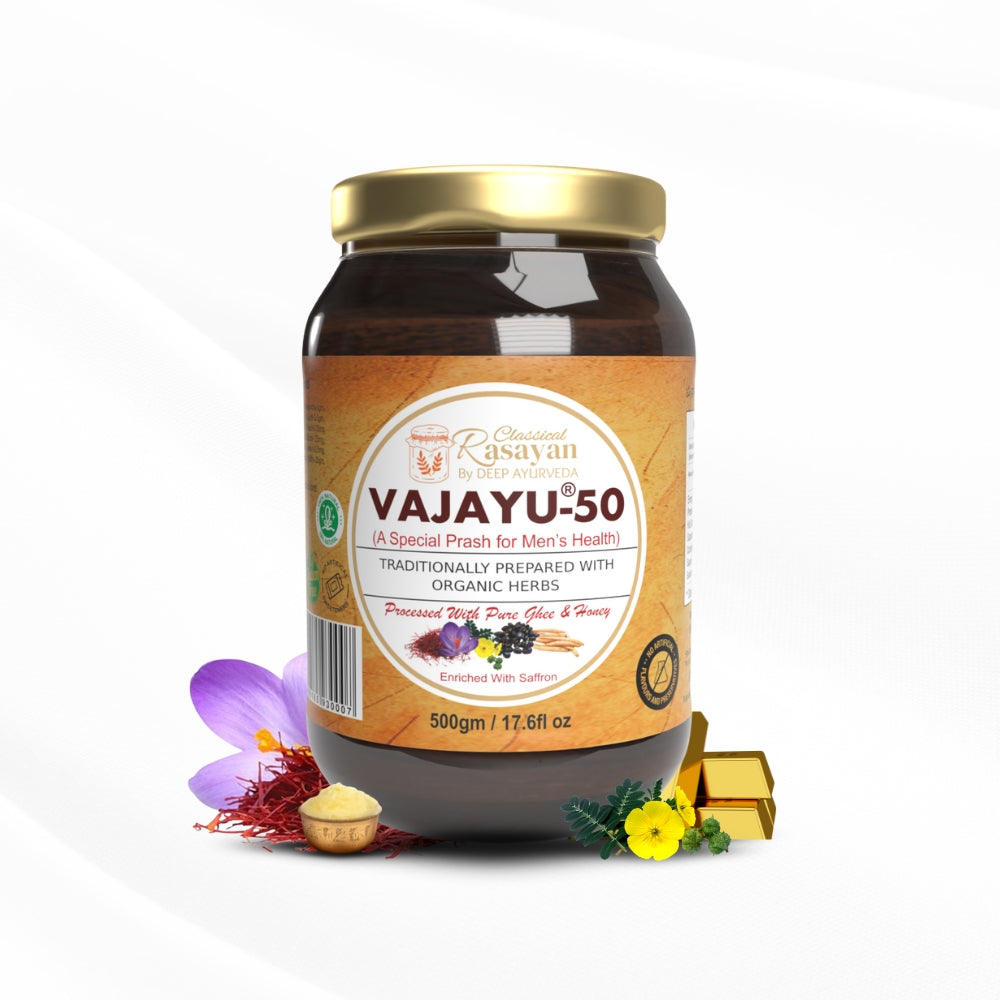News
Tulsi (Holy Basil): The Ultimate Winter Immunity Booster
Winter in India often brings cold, cough, flu, and low immunity—but Tulsi (Holy Basil) offers a natural, effective solution. Known as the “Queen of Herbs,” Tulsi boosts immunity, supports respiratory health, reduces stress, and promotes overall well-being. From Tulsi tea and fresh leaves to herbal kadha, this ancient herb combines Ayurvedic wisdom with modern research to keep you healthy all winter. Learn how to use Tulsi safely and effectively for a stronger, more resilient you.
Read moreNews
सर्दियों में च्यवनप्राश के फायदे in Hindi
सर्दियों में इम्युनिटी बढ़ानी हो, एनर्जी चाहिए हो या रोज़मर्रा की सेहत को मजबूत बनाना हो — च्यवनप्राश एक प्राकृतिक आयुर्वेदिक फॉर्मूला है। इस ब्लॉग में हमने च्यवनप्राश के फायदे, सही सेवन का तरीका, इसके अंदर शामिल मुख्य जड़ी-बूटियाँ, बच्चों-बड़ों के लिए लाभ, और रोज़ाना कितनी मात्रा में लेना चाहिए — इन सबको सरल हिंदी में समझाया है।
Read moreTriphala Churna Benefits: A Complete Ayurvedic Guide for India
Triphala Churna is one of the most trusted Ayurvedic remedies for digestion, detox, immunity and overall wellness. This guide explains how Triphala works, its top benefits, correct dosage, best time to take it, and possible side effects. Learn why this 2,500-year-old formula is still the most recommended natural solution for Indian households.
Read moreShatavari Benefits for Men: Evidence, Uses, Dosage
Shatavari can help men boost libido, fertility, stamina, digestion, and stress resilience. This guide explains its science-backed benefits, dosage, safety, and the best ways to use it daily.
Read moreशिलाजीत के फायदे (shilajit ke fayde)
शिलाजीत एक प्राकृतिक हर्बल रेज़िन है जो ऊर्जा, स्टैमिना, पुरुष स्वास्थ्य, फोकस और इम्यूनिटी बढ़ाने में मदद करता है। इस ब्लॉग में इसके फायदे, सही मात्रा, कैसे लें, कब लें और असली शिलाजीत पहचानने के आसान तरीके संक्षेप में बताए गए हैं।
Read moreShilajit Gummies : Benefits, Uses, Side Effects & Best Choices in India
What Are Shilajit Gummies & Why Everyone Is Talking About Them? In recent years, shilajit gummies have become the go-to health supplement for many in India. Whether you’re a fitness enthusiast, a busy professional, or someone who’s just looking to improve their overall well-being, these gummies offer an easy and convenient way to consume the powerful benefits of shilajit. But why are people talking about them so much? What Is Shilajit? Shilajit is a natural substance found in the Himalayas, often referred to as “the destroyer of weakness” due to its wide range of health benefits. Traditionally, it’s consumed in resin or powder form, but many find these methods difficult due to their strong taste, texture, and complex preparation. Enter shilajit gummies — an easy, tasty, and convenient way to experience all the goodness of shilajit without the hassle. If you're wondering whether shilajit gummies can help you, you’ve come to the right place. In this guide, we’ll walk you through everything you need to know about shilajit gummies — from their benefits and uses to potential side effects and the best options available in India. What Exactly Is Shilajit? Shilajit is a natural resin that oozes from rocks in the high-altitude regions of the Himalayas. It's packed with essential minerals, trace elements, and fulvic acid, which gives it its potent health benefits. For centuries, people in India and other parts of the world have used it as a traditional remedy for energy, vitality, and overall wellness. This ancient herb acts as a nutrient-dense superfood, boosting the body’s natural functions, improving metabolism, and even enhancing cognitive function. However, because of its bitter taste and sticky texture, consuming shilajit in its raw form can be quite challenging for many. That's where shilajit gummies come in — they offer all the benefits with none of the unpleasantness. How Shilajit Gummies Are Made Shilajit gummies are made by carefully extracting the purest form of shilajit resin and blending it with natural ingredients like fruit pectin, herbal extracts, vitamins, and flavours. The process involves purifying shilajit to remove impurities, followed by adding ingredients that make it easy to consume in gummy form. The result is a nutritious, easy-to-consume supplement that tastes like fruit but carries all the ancient wisdom and benefits of shilajit. Shilajit Gummies Benefits Shilajit gummies are not just a trendy health product. They offer a wide array of benefits that can improve both your physical and mental health. Here are some of the most important benefits: Boosts Daily Energy & Reduces Fatigue Shilajit is famous for its ability to boost energy levels and combat fatigue. This is because it contains essential minerals like iron, zinc, magnesium, and potassium that support better metabolism and energy production. If you find yourself feeling sluggish by the afternoon or struggling with low energy, adding shilajit gummies to your routine can help you stay energized throughout the day. Supports Testosterone & Male Performance One of the most well-known benefits of shilajit is its ability to boost testosterone levels naturally. Shilajit helps maintain a healthy balance of hormones, which can result in improved muscle strength, better libido, and overall male performance. It's particularly beneficial for men over 30 who may experience a decline in testosterone levels. Better Focus & Reduced Brain Fog Shilajit contains fulvic acid, which is known for its cognitive-enhancing properties. This acid helps in the absorption of vital nutrients and oxygen into the brain, improving memory, focus, and overall mental clarity. Whether you’re studying for exams, working long hours, or dealing with stress, shilajit gummies can help you stay sharp and alert. Supports Healthy Aging Shilajit is packed with antioxidants, which help protect the body from oxidative stress and the aging process. These antioxidants combat free radicals, slow down cellular aging, and promote healthier skin, hair, and nails. If you’re looking to slow down the signs of aging naturally, shilajit gummies might just be what you need. Immunity Support Shilajit is known to boost the immune system. Its minerals, including selenium and zinc, enhance immune cell function and help the body fight off infections. If you want to keep seasonal illnesses at bay, adding shilajit gummies to your daily routine could be a simple yet effective way to enhance your immunity. Good for Women Too While often marketed toward men, shilajit gummies are equally beneficial for women. The minerals and antioxidants help reduce stress, support energy levels, and balance hormones. Women experiencing fatigue, hormonal fluctuations, or stress can benefit significantly from incorporating shilajit gummies into their daily routine. Do Shilajit Gummies Really Work? The answer is yes! But as with any supplement, results may vary depending on factors like dosage, consistency, and individual body types. Shilajit gummies provide all the benefits of raw shilajit but in a more digestible and palatable form. However, it's important to remember that shilajit is not a "quick-fix" solution. It works gradually over time, so consistency is key. Users typically begin to feel the benefits after 3 to 4 weeks of regular use. Unlike traditional shilajit resin, which can be hard to dissolve or consume in large quantities, gummies offer a convenient way to get your daily dose without the hassle. How to Use Shilajit Gummies Recommended Dosage Most brands recommend taking 1 to 2 gummies per day, depending on the brand’s potency. It’s always a good idea to follow the recommended dosage mentioned on the packaging. Best Time to Take Shilajit Gummies For energy and stamina: Take 1 gummy in the morning before breakfast. For sleep and stress relief: Take 1 gummy in the evening about an hour before bed. For workouts: Taking it before or after your workout can help with recovery and performance. Important Tip: Stay hydrated when taking shilajit gummies. Water helps in better absorption of nutrients. Shilajit Gummies Side Effects & Safety Although shilajit gummies are generally safe, there are a few things to keep in mind: Mild nausea: If taken in excess, some people may experience mild nausea or stomach discomfort. Pregnancy and breastfeeding: Shilajit is not recommended for pregnant women or nursing mothers due to its strong potency. Chronic conditions: If you suffer from gout or are taking blood-thinning medication, consult a doctor before using shilajit gummies. Diabetics: Check the sugar content, especially if you are diabetic. Shilajit Gummies vs Raw Shilajit vs Capsules When comparing shilajit gummies to raw shilajit and capsules, each has its own set of benefits. Here's a quick comparison: How to Choose the Best Shilajit Gummies Not all shilajit gummies are created equal. When choosing the best option for yourself, keep these points in mind: Purity: Make sure it contains 100% pure Himalayan shilajit. Ingredients: Avoid artificial sugars, additives, or preservatives. Look for brands with natural sweeteners. Certification: Look for third-party lab testing or certifications for purity. Fulvic acid content: The higher the percentage of fulvic acid, the better. Shilajit Gummies Price in India The price of shilajit gummies varies depending on factors like purity, brand, and pack size. On average: Budget options: ₹300 – ₹600 for a 30-day supply. Premium options: ₹600 – ₹1200 for a 30-day supply, often with higher potency and purity. Who Should Take Shilajit Gummies? Shilajit gummies are suitable for: Gym-goers looking for an energy boost and recovery. Professionals seeking improved focus and reduced stress. Students looking for a natural cognitive enhancer. Adults over 30 experiencing low energy or hormonal imbalances. Women seeking natural support for hormonal balance. Who Should Avoid Shilajit Gummies? Shilajit gummies are not recommended for: Pregnant or breastfeeding women. Children under 18. People with gout or kidney stones. People on specific medications like blood thinners. Are They Worth Buying in 2025? After reviewing all the benefits, side effects, and available options, I can confidently say that shilajit gummies are worth considering if you’re looking for a natural energy boost, improved focus, and overall wellness. They are easy to consume, taste great, and offer a range of health benefits. Just remember to buy from a trusted brand and stick to the recommended dosage. Final Thoughts Incorporating shilajit gummies into your daily routine can be a simple, effective way to support your energy, immunity, and overall wellness. Just remember to choose a trusted brand, stick to the recommended dosage, and use them consistently for best results. FAQs Q1: Can I take shilajit gummies daily? Yes, you can take 1–2 gummies per day for consistent benefits. Q2: How long does shilajit take to show results? Results can vary, but typically it takes 3–4 weeks to experience noticeable changes in energy and wellness. Q3: Do gummies increase testosterone naturally? Yes, shilajit has been shown to support healthy testosterone levels, particularly in men. Q4: Are shilajit gummies safe for women? Absolutely! Women can benefit from improved energy, reduced stress, and hormonal support. Q5: Can diabetics take them? Diabetics should check the sugar content and consult their doctor before using shilajit gummies.
Read moreFlaxseed Benefits for Hair: The Complete Indian Guide to Stronger, Shinier, Healthier Hair
A quick and simple guide to flaxseed benefits for hair. Learn how alsi helps reduce hair fall, boost growth, add shine, and control frizz—using easy, natural Indian home remedies.
Read moreNeem Leaves Benefits: Complete Guide for Skin, Hair, Immunity & Health
Neem leaves are one of India’s most powerful natural medicines. In this post, discover the top neem leaves benefits for skin, hair, immunity, digestion, and overall health. Learn how to use neem safely, the right daily dosage, side effects, and the best ways to include neem in your routine.
Read moreManjistha Benefits: The Ayurvedic Secret for Glowing Skin, Detox & Inner Balance
Discover amazing manjistha benefits for glowing skin, detox, and better health. This Ayurvedic herb helps purify blood, clear acne, and support liver and hormonal balance — making it a natural beauty and wellness secret trusted in India for centuries.
Read moreMoringa Powder Benefits for Weight Loss
Discover how Moringa Powder helps in natural weight loss by boosting metabolism, reducing cravings, and balancing blood sugar — all backed by science and Ayurveda. Learn easy Indian ways to use it daily and get the best tips for safe, effective results.
Read moreVidarikand: Benefits, Uses, Dosage & Complete Guide
Vidarikand is a powerful Ayurvedic root known for boosting strength, improving stamina, supporting reproductive health, and enhancing immunity. This simple, in-depth guide covers all benefits, uses, dosage, and precautions of Vidarikand in an easy language that Indian readers love. Perfect for anyone looking for natural energy, hormonal balance, and overall wellness.
Read moreKanchnar Guggulu: Benefits, Uses, Dosage & Complete Guide
A quick and simple guide to Kanchnar Guggulu—its benefits, uses, dosage, and how it helps with thyroid, PCOS, cysts, and detox in a natural Ayurvedic way.
Read morePanch Tulsi Drops Benefits: Nature’s Power for Your Daily Health
Boost your immunity naturally with Panch Tulsi Drops by Deep Ayurveda — a powerful Ayurvedic blend of five Tulsi types for daily health and detox.
Read more














